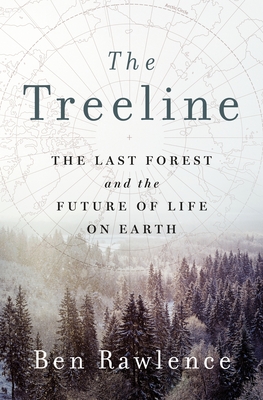
The Treeline: The Last Forest and the Future of Life on Earth
Staff Reviews
Visualize, if you will, the view of the top of the earth from a couple of hundred miles above the North Pole or, better yet, the view of the top of the head of a Medieval monk and his bald pate surrounded by a ring of hair. The latter element of the picture gives one what, in botanical/geographic terms, would be the Boreal Forest. The Treeline, by Ben Rawlence is an examination of that forest. Subtitled, The Last Forest and the Future Of Life On Earth, the book is serious, but also informative, and hopeful.
We often think of the Amazon jungle as the lungs of the earth, taking carbon dioxide from the atmosphere and giving us oxygen. It contributes, but Rawlence informs his readers, the Boreal Forest that rings the top of the world is the largest living system on earth after the ocean. It is this forest that is truly the planet’s lungs, and they are starting to wheeze.
In order to understand how the changes to the earth’s climate are affecting the treeline, Rawlence turns his research to six tree species, each found in different locations. All of which, however, teach him the same lessons of the fragile nature of the earth’s ability to remain sustainable.
He writes: “But now that humanity has upset the planetary system of oceans, forests, winds and currents, the balance of gases in water and air that gave rise to our species, their consolations are in question. Trees no longer offer comfort, but warning.”
Climate change is increasingly visible, from extended and more violent hurricane seasons, to drought, brutal summers, warmer winters, flooding and wildfire. The earth’s atmosphere is not the same as that in which we grew up, whether, 15 to 20 or 60 or 70 years ago, let alone back when the “monk” lived within cloistered walls. The changes are affecting the Boreal Forest, too. Its occupants are moving north as they are trying to find cooler climates they need to survive.
Beginning in Wales, where he lives, with the yew, Rawlence reports the tree was one of the first to root when the last Ice Age ended about 10,000 years ago. The tree, he writes, finds sustenance in marginal soil that offers little nutrition, the type of soil that was left after the glaciers scraped the earth’s surface bare.
“As the ice moved north, the treeline slowly followed, taking root in meager soil, photosynthesizing, shedding its needles, then dying to create the rich fertile crust of the earth, laying the foundations for the habitats of all other terrestrial life.”
He continues: “This bright green halo is moving unnaturally fast, crowning the planet with a laurel of needles and leaves, turning the white Arctic green. The migration of the treeline is no longer a matter of inches per century; instead it is hundreds of feet every year. The trees are on the move. They shouldn’t be.”
As the planet warms, the permafrost is melting, releasing carbon dioxide into the air. This, in turn, brings more warming allowing the trees to increase their march north. A vicious cycle is underway.
The forests on the treeline tell us this story is true. We learn about the yew, the Scots pine, the downy birch, the Dahurian larch, the white/black spruce, the balsam poplar and the Greenland mountain ash. And we learn about the geology, geography, biology and climate where they grow and the people who live in the far north regions of the countries that are their homes, from Wales to Scotland, to Scandinavia to Russia to Alaska and on across Canada to Greenland.
Rawlence points to how humans have evolved since the last ice age as have forests. In that adaptability he sees hope for the future if we can recognize our way of life is a tiny dot in the span of time. We, and the trees that are the cornerstone of life, have lived and grown under industrial capitalism and colonialism, but that is also leading to the demise. That is not, however, the only model of life that occurred through the ages. He suggests it is incumbent that we recognize this and determine to use our ingenuity to create a new model that will find harmony in biodiversity rather than viewing what exists on the planet, including ourselves, as commodities to be bought and sold.
The book is far more than a botany text nor is it a political screed. Rawlence’s writing is clear, vivid and, at times, almost poetic. His words are there to be read and pondered. His message is critical thinking is needed to open our eyes to search for the unseen possibilities that stretch before us and wrap around us. The people of the far north he encountered, and the trees, show that adaptation is possible, and necessary.
As we look around us and recognize the recent, dramatic and dynamic changes that are occurring to the planet and human life on earth, we don’t have much choice but to confront this reality and change. We do or our children and grandchildren won’t have the memories of a livable world that has been ours for a very short time in the span of time.
Description
Winner of the 2023 Helen Bernstein Book Award for Excellence in Journalism
"Original and readable." ―Financial Times' Best Environmental Books of 2022
"Superb, inspiring." ―Winner, National Academies of Science Schmidt Awards for Excellence in Science Communications
“Illuminating.” —Silver Medalist, National Outdoor Book Awards
Longlisted for the American Library Association's 2023 Carnegie Medal for Excellence in Nonfiction
Finalist, 2023 Banff Mountain Book Competition
Finalist, 2023 Dayton Literary Peace Prize
In the tradition of Elizabeth Kolbert and Barry Lopez, a powerful, poetic and deeply absorbing account of the “lung” at the top of the world.
For the last fifty years, the trees of the boreal forest have been moving north. Ben Rawlence's The Treeline takes us along this critical frontier of our warming planet from Norway to Siberia, Alaska to Greenland, Canada to Sweden to meet the scientists, residents and trees confronting huge geological changes. Only the hardest species survive at these latitudes including the ice-loving Dahurian larch of Siberia, the antiseptic Spruce that purifies our atmosphere, the Downy birch conquering Scandinavia, the healing Balsam poplar that Native Americans use as a cure-all and the noble Scots Pine that lives longer when surrounded by its family.
It is a journey of wonder and awe at the incredible creativity and resilience of these species and the mysterious workings of the forest upon which we rely for the air we breathe. Blending reportage with the latest science, The Treeline is a story of what might soon be the last forest left and what that means for the future of all life on earth.
Praise for The Treeline: The Last Forest and the Future of Life on Earth
Conde Nast Traveler, Best Books to Read on the Beach This Summer: "A fascinating and relevant read." —Jenna Hamm, owner/operator of Camp Denali
One of Booklist's Top 10 Environmental Sustainability Books
"A sounding alarm, and a call to action."
―NPR's Best Books/Books We Love
"You feel the layering of [Rawlence's] heightened noticing throughout the book."
―Verlyn Klinkenborg, The New York Review of Books
"Written with refreshingly lovely and occasionally aching prose."
―James Tarmy, Bloomberg
"Important."
―Minneapolis Star Tribune
"[A] trip to six boreal forests around the world (Scotland, Scandinavia, Siberia, Alaska, Canada, and Greenland)...worth the effort."
―Miami Herald
“Compelling, intriguing, and thoroughly engaging …The Treeline is a game-changer.”
―Booklist (Starred)
“Rawlence evokes the natural world in lyrical, delicate prose … A timely, urgent message delivered in graceful fashion.”
―Kirkus (Starred)
"Eloquent...Nature lovers and travelers alike will find this a lovely paean to a rapidly changing landscape."
―Publisher's Weekly
"Lyrical and passionate."
―Mail on Sunday
"Clear-headed, perspective-altering book... a beautiful and evocative portrait of the natural world. It is essential reading for those hoping to better understand our changing planet."
―The Spectator
"Rawlence is a fine ecologist and an excellent writer... Timely, salutary and eminently readable. Excellent."
―Resurgence & Ecologist
“The book’s many detailed descriptions of the natural world are coupled with contemporary climate science, making the process of learning about the forest’s inner workings both awe-inspiring and ineffably sad.”
― Undark
"Absolutely fantastic and devastating."
―Emma Gannon, host of Webby nominated podcast Ctrl Alt Delete
"Thought-provoking."
―Gardens Illustrated
"What an extraordinary book this is! ... This is not just a description of a warming world but an active invitation to live differently, to participate with wisdom and humility in the cacophonous and ever-unfinished abundance of terrestrial life."
―Ben Ehrenreich, author of Desert Notebooks
"Utterly illuminating."
―Sophy Roberts, author of The Lost Pianos of Siberia
"In this beautiful homage to the world’s northernmost forests, Ben Rawlence brings the zeal of a journalist and the heart of a naturalist to his journey following the treeline east into the rising sun. As Rawlence explores vast wildwoods of pine, birch, larch, and spruce, he uses alluring prose to present fascinating and challenging ideas of what a forest is: not a static place on a map but a creative, evolutionary process―a “mobile community." Rawlence documents how the treeline is now undergoing one of its greatest transformations with enormous consequences for humanity and the planet. By focusing his formidable curiosity and craft on the arboreal biosphere, Rawlence has given both trees and people an enormous gift."
―M.R. O'Connor, author of Wayfinding
“A moving, thoughtful, deeply reported elegy for our vanishing world and a map of the one to come."
―Nathaniel Rich, author of Losing Earth and Second Nature
"Rawlence takes us on an unforgettable personal tour of the major treelines of the Northern Hemisphere. His prophetic insights on how global climate change is rapidly rewriting the boundaries and biodiversity of earth’s boreal forests are colored by the insights of the botanists, glaciologists, and indigenous peoples he met along the way. The Treeline is a page-turner that poetically challenges us to confront the elephant in the room."
―James McClintock, author of Lost Antarctica and A Naturalist Goes Fishing
"Urgent and insightful tour of some of the world’s strangest, most bewitching and most endangered environments... A tribute to indigenous wisdom, a paean to the otherworldly beauty of the taiga and the tundra, and a highly readable overview of the latest science. This is an important book, and one I will be pressing into other people’s hands."
―Cal Flyn author of Islands of Abandonment
"Evocative, wise and unflinching."
―Jay Griffiths, author of A Sideways Look at Time

